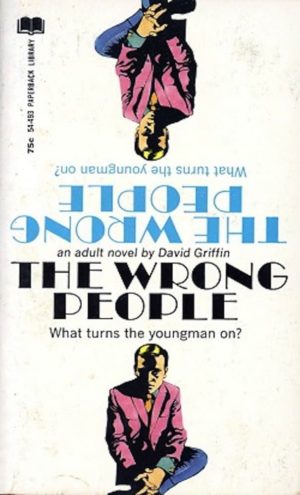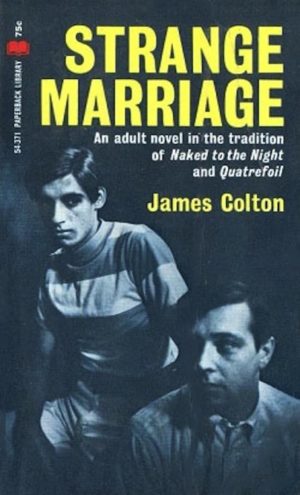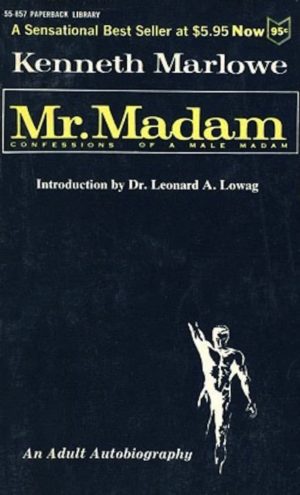PL-54-871 Quatrefoil
Quatrefoil
Paperback Library
PL-54-871
James Barr
$0.75
INTRODUCTION
Those of us who had grown up in the years from 1920 to 1950 had found them to be—as Dickens said—both the best of times and the worst of times. It was a span of years when everyone stayed deep in the closet, save those who had been caught in flagrante delicto and been publicly disgraced or fired or disciplined in some way. Still, those of us who could maintain our secret lived under an extraordinary protective umbrella: the ignorance and naiveté of the American public which—save for the pockets of sophistication in the metropolitan centers—spread far and wide over the rest of the land. And under the umbrella we lived and moved and made love and enjoyed our beddings, told our jokes and in general found life happy.
Because of our parasol’s protection, the view of homosexuality—if indeed it were ever thought of—was very quaint in America. It was based on the assumption that all people raised in civilized Christian countries knew better than to fall in love with persons of the same sex. Knowing better, then, the narrow fundamentalist mind made two astonishing leaps of illogic: (a) people did not do such things, and (b) such things must be non-existent. Oh, yes, perhaps in Paris or those wicked foreign cities, but never in God-fearing macho America the beautiful! We existed under the shadow and cover of such naiveté—and only when the audience grew more sophisticated did our long ordeal begin once more.
Quatrefoil, published in 1950, dealt soberly and intelligently with homosexual love; it soon proved to be the best novel up to that time concerned with love between men.
It was not the first of the books on a homosexual theme.
Eagerly we had bought, read, and treasured certain novels of the 1920s, ’30s, and ’40s. The gay and delicious little giggling gewgaws of Carl Van Vechten delighted us, filled as they were with their double-entendres and secret jokes for homosexuals.
There were a few short stories by Willa Cather and Sherwood Anderson, as well as two great classic novellas—Thomas Mann’s Death in Venice and Andre Gide’s The Immoralist.
Following these in the 1930s came a number of wooden productions, portraying the homosexual scene as giddy or semi-tragic or downright awful—with the protagonist always getting killed or committing suicide, thus showing the guards of public morals that Sin, especially homosexual Sin, always came to a bad end.
In this group were Goodie, Butterfly Man, Twilight Men, Strange Brother, and a creepy campy little horror called A Scarlet Pansy, all of which ended in death, disorder, or disaster.
The 1940s were a little better. During this decade authors found themselves able to write a trifle more sympathetically about their homosexual protagonists. Charles Jackson’s The Fall of Valor enjoyed great popularity, and there were rumors that it would be turned into a movie, but it never was. Gore Vidal’s The City and the Pillar was certainly the most explicit novel of the decade; in it two young men, for the very first time in American fiction, not only undressed together but actually kissed! Truman Capote, Carson McCullers, John Home Burns, Ward Thomas, Harlan MacIntosh, Nial Kent and others produced novels with homosexual themes showing varying degrees of talent and forthrightness.
We read all of these novels, and even marked especially attractive passages. Sometimes with moist eyes and tremulous lips we assured our friends that here was a “must read.” But we were still closeted, and currently with greater stress than ever, for our beloved umbrella had become a thing of shreds and patches as the nation’s knowledge and sophistication increased. It now hardly protected us at all. The publication of Kinsey’s Sexual Behavior in the Human Male in 1948, although it did much good for our cause, also stripped away the last tatters of silk, to leave only the metal ribs above us. It remained then for Senator McCarthy with his rumors and accusations to shatter everything and to send us scurrying deeper into our closets than ever, to escape utter destruction.
The protagonists of Quatrefoil realized this, and with subterfuge and skill waged an eternal battle to remain closeted, for they were both in the Navy, the young Ensign Froelich and the older Commander Danelaw. They successfully concealed their love for each other, living by a deceit which was forced upon them, dangerously skirting discovery and escaping it only by clever fabrications and skillfully invented fictions, compelled to stand guard over every gesture from pinkie and limp wrist, to sibilance in their voices and lilt in their inflections In some ways Quatrefoil was a wonderful treatise on how to live happily in the closet in 1950.
The world of Froelich and Danelaw is thus somewhat puzzling to the modern reader who comes across it thirty years later. He finds it difficult to understand. Yet here laid out in Quatrefoil is a graphic and accurate picture of the secrecy and concealment that was necessary in those days. For these reasons Quatrefoil is valuable, and for the fact that it is among the best-written homosexual novels of the time, a genuine classic, an appealing romantic love story.
There are some flaws in the book, to be sure, but they are made tolerable by the good writing and the positive approach.
There are many superficial and condemnatory words about homosexuality in the novel—such as “ugly,” “indecent,” “diseased,” “vile,” and “corrupt”—but the standards of the times made it necessary for them to be used.
Ensign Phillip Froelich is a handsome and romantic young man, and Commander Danelaw an attractive, wise, and knowledgeable mentor for him. Both of them are people one would like to know. All the characterizations in the book are firm, some more developed than others; and the novel is strained through the consciousness of Froelich. Thus we see clearly enough into the minds and personalities of the other characters.
We can admire, although not necessarily agree with, his firm determination—common to so many homosexuals in the past—to be an individual, standing alone, finding all the answers within himself and never identifying with any group. The two protagonists of Quatrefoil are sane and well-balanced, evidence of Kinsey’s statement that homosexuality is simply another channel taken by man’s sexual instinct, as “normal” for him as for any other mammal.
Standards shift whenever people progress. The changes that have occurred since 1950 are almost unbelievable. The world of Timothy and Phillip was one without adult bookstores, x-rated movie houses, orgy backrooms, amyl nitrate, LSD or Quaaludes. There were no photographs of unclothed males, save those in posing-straps or loincloths, nor were there any homosexual organizations. On radio and television there was a rigid code of behavior to be followed when a man and a woman were alone, and you could not say words like “pregnant” or “whorehouse” over the air or in movies. The homosexual, when he was portrayed, was a stereotypical one—limp-wristed, plucked, marcelled, and effeminate. But Timothy and Phillip were not.
Although their lives were troubled, they triumphed, and their story is a tribute to the human spirit.
—Samuel M. Steward




Reviews
There are no reviews yet.